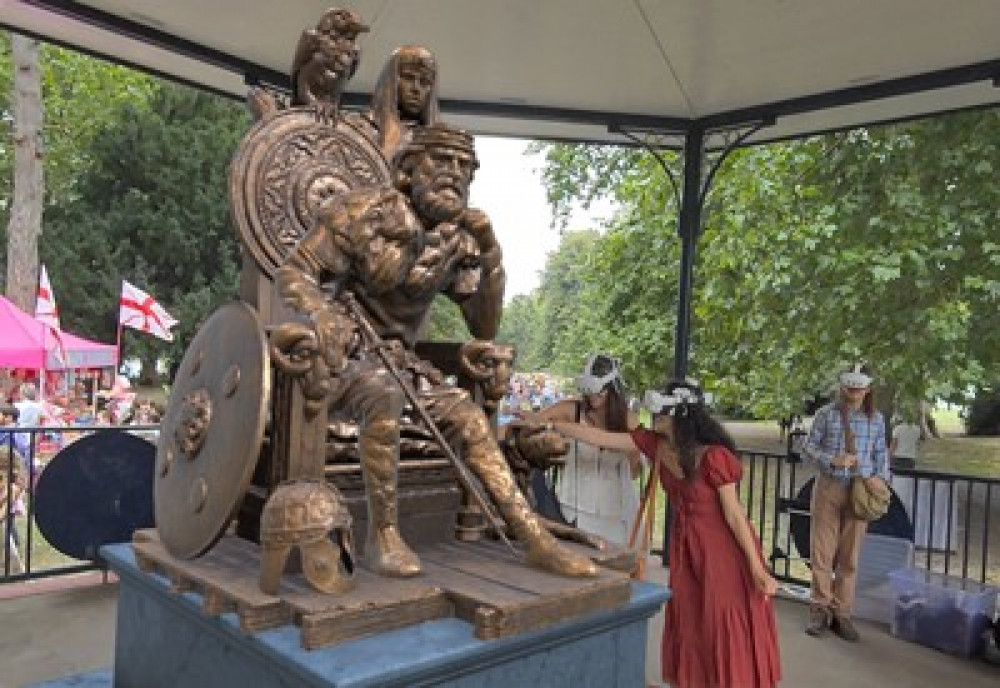King Athelstan brought to life with VR and AI in Kingston University project celebrating 1,100th coronation anniversary
By Tilly O'Brien 5th Aug 2025
By Tilly O'Brien 5th Aug 2025

Artificial intelligence (AI) and virtual reality (VR) have been used in combination for a project which aims to create an engaging new interpretation of a statue of King Athelstan, widely regarded by historians as the first King of England.
The King Athelstan project, launched to celebrate the 1,100th anniversary of the King's coronation, which took place in Kingston in 925, is based on an original maquette by world-renowned sculptor Andrew Sinclair and uses VR and augmented reality (AR) to create an immersive experience highlighting the King's reign and giving visitors a taste of life in the Saxon period.
The University's computer science experts partnered with Sinclair to add an artistic dimension by unveiling the sculpture exclusively in VR and AR using a VR headset with mixed reality and hand-tracking, making it an interactive experience.
The features include the eyes of the King and his aunt Aethelflaed following headset-wearing visitors as they make their way around the 360-degree sculpture, while the head and tail of the King's dog, a symbol of loyalty, and a raven representing wisdom also animate – bringing the statue to life.
The project is funded by Kingston University's Knowledge Exchange Research Institute (KERI) Collaboration Grant, with the University's Institute of Cyber, Engineering and Digital Technologies and Institute of Design, Arts and Creative Practice working together to develop a bold interdisciplinary approach combining fine art, immersive technology and historical storytelling.
The project recently became an official partner of Kingston 2025, a cultural programme led by Kingston Council to mark the anniversary.
Two major public events took place earlier this summer at Kingston Market House and Canbury Gardens to showcase the sculpture and to invite residents to see the statue in interactive format and learn about the Saxon era.
Computer animation alumni, Christel 't Hoen and Joana Sousa Dias, contributed to the project and were responsible for 3D modelling, texturing and animation, while current computer games programming student, Matteo Marelli, helped with software development of an AI-driven voice-based storytelling agent.
Local businessman, Alan Birkinshaw, who works for a local sculpting company served as the project's business coordinator.
Music expert at Kingston University, Dr Leah Kardos, has recently joined forces with her computer science colleagues to further develop the project. She and her team have begun creating a spatial audio soundscape and adaptive music composition.
Senior Lecturer in Games Development and Design, Dr Jarek Francik, who is leading the project, said the ultimate goal was to promote local pride and community spirit while entertaining and educating people about Kingston upon Thames' historic past.
He added: "Through immersive storytelling and interactive engagement, we are aiming to bring King Athelstan's era to life in an unprecedented and innovative way through cutting-edge technology."
"Working together with colleagues in the music department, these groundbreaking advances will help audiences understand the area's local history and reinforce the project's role as a cultural highlight of Kingston 2025."
Dr Kardos said her team wanted to make it an interactive experience for visitors.
She added: "Drawing on research into Saxon-era music and instruments, our team (Dr George Reid and Robert Plummer in Performing Arts) combined historically inspired composition and sound design into an adaptive soundscape to enrich the immersive VR experience and deepen its emotional and educational impact.
"The sound and music respond to where visitors move and look, connecting historical storytelling with cutting-edge audio technology."
CHECK OUT OUR Jobs Section HERE!
kingston vacancies updated hourly!
Click here to see more: kingston jobs
Share:






